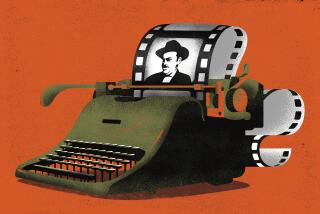FILM / PAT H. BROESKE : Author Seeks General Appeal in âKaneâ Book : To mark the movieâs 50th anniversary, Harlan Lebo, a writer who got his start in Orange County, offers a work rife with illustrations, reproductions of documents, reviews, souvenir program and more.
Since its premiere on May 1, 1941, at the RKO Palace in New York City, Orson Wellesâ âCitizen Kaneâ has come to be recognized as one of the most influential movies ever made. Not surprisingly, its 50th anniversary is being observed with a good deal of hoopla, ranging from critical re-examinations (and a reprise of those accolades) to the theatrical run of a restored print, which has made its way to Orange County.
Meanwhile, a book marking the occasion--âCitizen Kane: The 50th Anniversary Albumâ--has been turned out by a writer who got his start in Orange County. The handsome, heavily illustrated, $29.95 Doubleday publication is by Harlan Lebo, a 35-year-old who was an editorial assistant at Newport Beach-based Road & Track magazine and who later, from 1978 to 1980, was an editor of the now-defunct sister magazines Orange County Illustrated and Orange County Business.
Currently director of communications for the College of Letters and Science at UCLA, Lebo said he approached Doubleday with the idea for a âCitizen Kaneâ book that would be of more âgeneral interestâ than such works as Pauline Kaelâs massive volume, which explores the origin of the filmâs script.
Film students and scholars everywhere know and relish the saga of âKane,â produced, directed, co-written by and starring 25-year-old upstart Welles, who already had made a name for himself on radio by faking a Martian invasion that terrified the nation. A chronicle of the rise and fall of Charles Foster Kane--a thinly disguised William Randolph Hearst--the film was so threatened by lawsuits that it was pulled from theaters shortly after its release.
âKaneâ eventually found fans in Europe (but of course) and, after it was shown on TV in 1956, a whole new generation of admirers in this country. In 1962, it was named the best film of all time in a Sight and Sound magazine poll, an honor it captured again in 1972 and 1982.
In January of 1989, four years after Welles died, angry headlines followed Turner Entertainmentâs announcement that it would colorize the film for video. But Wellesâ creative control over the project extended contractually to any tampering after his death, and Turner had to cancel its plans.
Along with many previously unpublished photos and a chapter-by-chapter study of how the film came to be, Leboâs book includes reproductions of archival documents, including letters from the Hays Office, which censored films of the day (one letter nixes a scene set in a brothel), and the original âKaneâ souvenir program which, among other things, touts the filmâs revolutionary cinematic techniques.
Thereâs also a roundup of the reviews that followed the filmâs original release. Typical is the declaration from the New York Timesâ Bosley Crowther that âit comes close to being the most sensational film ever made in Hollywood.â
Though Lebo got the green light from Doubleday in October of 1989, production demands meant that he had less than four months to research and write the book and still make the 50th anniversary deadline. Meanwhile, he also had to work full time at UCLA.
âIt was tricky,â he said. He ended up working several hours before work each morning, several hours each night, âand all day Saturdays and Sundays.â
Luckily, certain things worked in his favor. Production files and script drafts for âCitizen Kaneâ are at UCLA . Co-star Joseph Cottenâs scrapbooks are nearby at USC. And many photos chronicling the making of the film are at the Academy of Motion Picture Arts and Sciencesâ library, also in Los Angeles. Through the mails, Lebo was able to acquire copies of Wellesâ papers from the University of Indiana.
Lebo also conducted a handful of interviews, including one with Robert Wise, who edited âCitizen Kaneâ (and ended up writing the foreword for Leboâs book). Cotten was unreachable, seriously ill with throat cancer. In the cases of actors and production people long since dead, Lebo borrowed from previously printed interviews, including a series that filmmaker Peter Bogdanovich had conducted with Welles.
The initial press run of 10,000 will be more than tripled in the fall, when Turner Home Entertainment buys 25,000 copies, to be sold in special packages with the re-released âKaneâ video.
âCitizen Kaneâ (1941) is being shown at the Balboa Cinema, Newport Beach , (714 ) 675-3570 , and Edwards South Coast Plaza Village, Santa Ana , (714 ) 540-0594.
More to Read
Sign up for our Book Club newsletter
Get the latest news, events and more from the Los Angeles Times Book Club, and help us get L.A. reading and talking.
You may occasionally receive promotional content from the Los Angeles Times.








